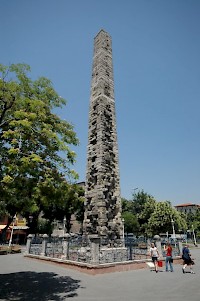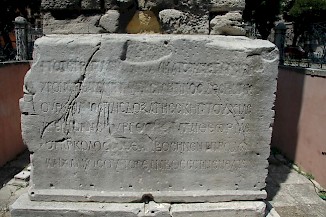Constantinople, Hippodrome, Second Obelisk
Q55323469The "Second Obelisk": Medieval moument in the Hippodrome of Constantinople.

The Hippodrome of Constantinople was the place for horse races. The chariots several times had to round the spina, the longitudional barrier in the center of the circus, which was decorated with several monuments, like the Serpents' Column, the Obelisk of Theodosius, the two Porphyrius monuments, and the so-called Obelisk of Constantine Porphyrogenitus.
This monument is about thirty-two meters high and is not a real obelisk from Egypt, cut out of grey or pink granite: it is in fact made of natural stones, which explains why it is also known as the "Walled Obelisk". It was decorated with plates of gilded bronze, embossed with representations of the victories of the emperor Basilius I the Macedonian (r.867-886). These plates were removed in 1204 when the city was sacked by the Crusaders.

It is often said that the monument was erected by Basilius' grandson, Constantine VII Porphyrogenitus (r.913-959). This is based on a misreading of the inscription at the pedestal, which in fact records repairs to the obelisk, and compares it to the Colossus of Rhodes
It is likely that the core of the monument belongs to the oldest building phase - the hippodrome was built in 203 CE - because it stads exactly in the center and later monuments had to be erected on lesser places.
On top of the monument was a gilded globe, not unlike the one on top of the obelisk near the Montecitorio palace in Rome. These spheres made it possible to use the obelisk as the needle of a sundial.note